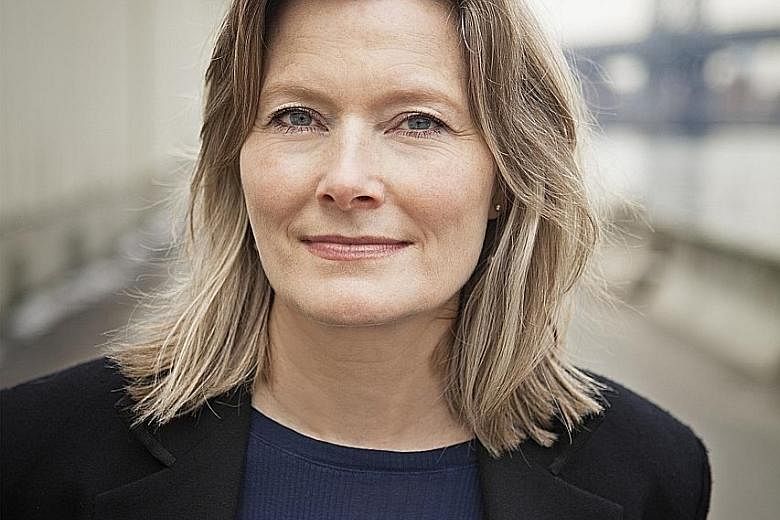When American author Jennifer Egan realised that a character in her novel was going to go out to sea on a ship, she felt "crushed".
Up to that point, her fifth novel Manhattan Beach had already demanded an immense amount of research.
In order to write authentically about 1940s New York, she had already had to research the waterfront, the mob, the cars people drove, the cigarettes they smoked and so much more.
"To add shipping on top of that felt impossible," says the 55-year-old over the telephone from her home in New York.
"I thought, I cannot do that, I cannot go to sea, I don't have the ability to accumulate the knowledge I'm going to need to write persuasively about this.
"But I couldn't seem to head it off. It just had to happen."
Manhattan Beach is a sprawling novel set in Depression-era and wartime New York that moves from the Brooklyn Naval Yard to the city's criminal underworld to a merchant ship crossing the Atlantic.
It is an unusually straightforward historical novel for Egan, who has made a name for herself as a highly experimental writer.
Her 2010 book, A Visit From The Goon Squad, which won the Pulitzer Prize for Fiction and National Book Critics Circle Award (Fiction), comprises 13 connected stories that play with form. One chapter presents a young girl's perspective in the form of a PowerPoint presentation.
In 2012, she published Black Box, a science-fiction short story that was serialised in tweets on The New Yorker's Twitter account over nine days.
Egan says she did try experimenting with making Manhattan Beach a self-conscious take on the historical novel, but this produced results that were "flat and kind of annoying".
"The book was most alive when I let the illusion of being in the past remain unbroken," she says.
She spent 13 years researching Manhattan Beach, which has already been longlisted for the National Book Awards in the United States.
Since the terrorist attacks of Sept 11, 2001, she has found herself contemplating the trajectory of American power in the world.
"It led me to think about what led my country to have this inordinate power in the world," she says, "what it felt like to be in the middle of this country when that power was coalescing for the first time."
This time, she believes, was when America entered World War II in 1942.
In the course of her research, Egan interviewed close to 50 people who had lived through the war: women who had worked in the Naval Yard, former mariners she met on a voyage aboard the SS Jeremiah O'Brien, one of the last functioning Liberty ships built during the war, and deep-sea divers.
She got to know a club of veteran army divers and attended their yearly reunion, where they dressed her in a Mark V diving suit and had her walk around in it.
"It was so painful," says Egan, who has never actually gone diving. "Wearing 200 pounds (90.7kg) is no joke. It was hard to walk - I just shuffled."
At the reunion, an octogenarian diver who had helped to bring up bodies when the Japanese bombed Pearl Harbour revealed to Egan that he had once met a female diver in the Russian army.
"That was so thrilling for me to hear," says Egan, who went on to use that as inspiration for her heroine Anna Kerrigan, a young Naval Yard worker determined to become the Yard's first female diver, despite the gruelling and dangerous conditions and the opposition of her commanding officer.
Egan, aware her earlier books have been somewhat skewed towards the male perspective, wanted this time to write about female power.
"There was this striking moment during the war when men disappeared and women were strongly encouraged to do all kinds of work they had never been able to do before," she says.
"Yet, that was all taken away from them once the war was over."
She interviewed a woman who was a first-class welder during the war, but was fired afterwards from the Naval Yard along with the rest of the women to free up jobs for the returning men. "She went around to all the mechanic shops in town to try to get work as a welder and the men just laughed at her."
Egan, who is married with two teenage sons, began writing due to panic attacks she experienced while backpacking alone through Europe aged 18.
She wrote constantly in her journal, narrating her own panic. While this did not stop the bouts of terror, it helped to anchor her through them and later inspired her to become a writer.
She has a longstanding obsession with water, which holds the numerous threads of Manhattan Beach together, from the corrupt gang-infested waterfront to the limitless expanse of the ocean.
"New York exists as a city because it is a port," she says. "Everything came and went through the water. It has that inkling of the eternal about it."
Now that her 13-year jaunt into historical fiction is over, she feels ready to return to experimental writing - although she notes that the 19th-century novel, which she used as a model for Manhattan Beach, also constituted cutting-edge experimentation back in the day.
"It's exciting to think about the time when the novel was the pre-eminent form of cultural escapism," she says. "Of course, fiction has been tremendously marginalised by screens in all the years since then, but I am often struck by the breadth and gutsiness of 19th-century fiction, how it had no hesitancy on approaching anything."
She hopes to write a companion volume to Goon Squad, which will follow more peripheral characters around in other directions.
"I was pretty tired of experimentation and myself not doing it with a whole heart," she says. "But now I'm curious again and ready to start doing some kooky stuff."


